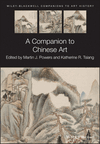Words in Chinese Painting
Alfreda Murck
Search for more papers by this authorAlfreda Murck
Search for more papers by this authorMartin J. Powers
Search for more papers by this authorKatherine R. Tsiang
Search for more papers by this authorSummary
This chapter examines one of the most obvious features of Chinese painting: the words written on them. The calligraphy enhances the image while the words extend the meaning. Although the focus of this chapter is on brush-written inscriptions on two-dimensional surfaces, it is important to remember the role of writing in early antiquity. The function of inscriptions in China evolved along with the perception that the written language was pictographic and magical. In the hierarchy of the arts, poetry traditionally was considered superior to painting. The eleventh century painting titles began to change from identifications to evocations of a mood or suggestion of a scene. To the extent that seals (popularly called chops) insert words onto paintings, they must be considered in the word-image complex. Many of the vernacular paintings made for women reveal a range of topics not dealt with in literati painting.
References Further Reading
- Barnhart , R. ( 2003 ). Concerning the Date and Authorship of the Admonitions Handscroll . In S. McCausland (ed.), Gu Kaizhi and the Admonitions Scroll . London : British Museum Press , pp. 85 – 88 .
- Bol , P. K. ( 1992 ). “This Culture of Ours”: Intellectual Transitions in T'ang and Sung China . Stanford, CA : Stanford University Press , pp. 53 – 58 .
- Bush , S. ( 1971 ). The Chinese Literati on Painting: Su Shih (1037–1101) to Tung Ch'i-ch'ang (1555–1636) . Cambridge, MA : Harvard University Press , p. 25 .
- Bush , S. and Shih H. Y. ( 1985 ). Early Chinese Texts on Painting . Cambridge, MA : Harvard University Press , pp. 135 , 278 – 279 .
- Cahill , J. ( 2010 ). Pictures for Use and Pleasure: Vernacular Painting in High Qing China . Berkeley : University of California Press , pp. 23 – 25 .
- Carrier , D. ( 2000 ). The Aesthetics of Comics . University Park : Pennsylvania State University Press , p. 41 .
- Cook , C. A. and Major , J. S. (eds.) ( 1999 ). Defining Chu: Image and Reality in Ancient China . Honolulu : Hawaii University Press , pp. 171 – 176 .
- Dunhuang ( 1989 ). Zhongguo shiku: Dunhuang Mogao ku , vol. 1. Beijing : Wenwu chubanshe , plates 124 – 128 .
- Ebrey , P. B. ( 2008 ). Accumulating Culture: The Collections of Emperor Huizong . Seattle : University of Washington Press , pp. 114 – 116 .
- Hartman , C. ( 1986 ). Poetry . In W. H. Nienhauser , C. Hartman , Y. W. Ma , S. H. West (eds.), The Indiana Companion to Traditional Chinese Literature . Bloomington : Indiana University Press , pp. 59 – 74 .
- Ho , W.-K. ( 1992 ). The Century of Tung Ch'i-ch'ang 1555–1636 . Seattle : The Nelson-Atkins Museum of Art in association with the University of Washington Press , pp. 7 – 9 .
- Holzwarth , G. ( 2005 ). Mount Pan . In E. Rawski and J. Rawson (eds.), China: The Three Emperors (1662–1795) . London : The Royal Academy , p. 437 .
- Lau , D. C. (trans.) ( 1979 ). The Analects of Confucius . New York : Dorset Press , p. 86 .
- Lee , H. S. ( 2010 ). Empresses, Art and Agency in Song Dynasty China . Seattle : University of Washington Press , pp. 202 – 205 .
- Little , S. ( 2000 ). Taoism and the Arts of China . Art Institute of Chicago and University of California, Cat. No. 12, p. 132 .
- Liu , A. ( 2011 ). Yang Weizhen (1296–1370) and the Social Art of Painting Inscriptions , PhD dissertation. University of Kansas, pp. 184 – 188 .
- Murck , A. ( 2000 ). Poetry and Painting in Song China: The Subtle Art of Dissent . Cambridge, MA : Asia Institute, Harvard University Press , pp. 70 – 71 , 211–225.
- Murray , J. ( 1993 ). Ma Hezhi and the Illustrations of the Book of Odes . Cambridge : Cambridge University Press .
- Ouyang X. and Song Q. (comp.) (1060[ 1975 A]). Xin Tang shu , vol. 202. Beijing : Zhonghua , p. 5766 .
- Powers , M. J. ( 1991 ). Art and Political Expression in Early China . New Haven, CT : Yale University Press .
- Schapiro , M. ( 1996 ). Words, Script, and Pictures: Semiotics of Visual Language . New York : George Braziller , pp. 118 – 911 , 137–139.
- Spiro , A. ( 2003 ). Creating Ancestors . In S. McCausland (ed.), Gu Kaizhi and the Admonitions Scroll . London : British Museum Press , pp. 53 – 64 .
- Wu , T. ( 1997 ). Tales from the Land of Dragons: 1,000 Years of Chinese Painting . Museum of Fine Arts, Boston .
- Egan , R. ( 1994 ). Word, Image, and Deed in the Life of Su Shi . Cambridge, MA : Harvard University, Council on East Asian Studies , pp. 48 – 49 .
- McCausland , S. (ed.) ( 2003 ). Gu Kaizhi and the Admonitions Scroll . London : The British Museum Press .
- Rawski , E. and Rawson , J. (eds.) ( 2005 ). China: The Three Emperors (1662–1795) . London : The Royal Academy .
- Shanghai Museum (ed.) ( 2002 ). Jin Tang Song Yuan shuhua guobao teji . The Palace Museum, Liaoning Provincial Museum, Shanghai Museum



